%20(50%20x%2050%20px)%20(1).svg)
Marketing automation is becoming indispensable for Australian businesses. No-code tools now allow marketers to create workflows without relying on developers, saving time and reducing costs. By 2027, the global market for these tools is projected to hit $8.42 billion. Here’s a quick look at the top seven platforms transforming marketing automation:
| Tool | Key Features | Starting Price (AUD/month) | Best Use Case |
|---|---|---|---|
| Zapier | App integrations, conditional logic, webhooks | $20 | Workflow automation across apps |
| HubSpot | CRM, lead scoring, email campaigns, analytics | $50 | Aligning marketing and sales teams |
| LeadSquared | Multi-channel engagement, lead scoring | Custom | B2B lead management |
| Storylane | Interactive product demos, analytics | $40 | SaaS product showcases |
| Gumloop | AI-driven workflows, SEO tools, competitor analysis | $97 | Advanced marketing tasks |
| Databox | Data consolidation, custom dashboards | Free | Cross-channel performance tracking |
| Chatfuel | Social media chatbots, keyword recognition | $35 | Automating social interactions |
These tools empower businesses to automate tasks, improve efficiency, and focus on strategic goals. Start with free trials to find the best fit for your needs.
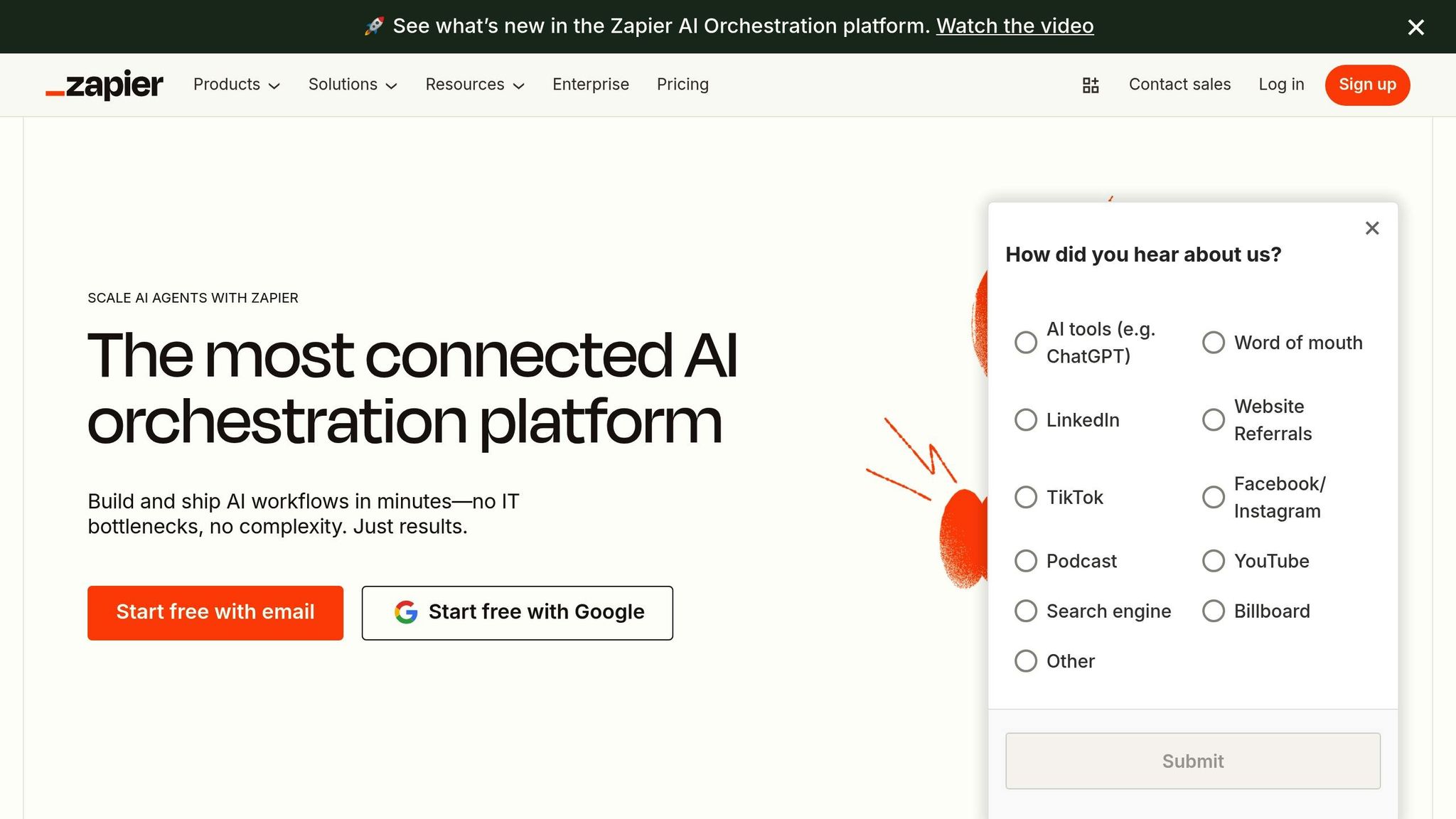
Zapier is a popular no-code platform that streamlines Australian marketing workflows. It enables users to create automated processes, known as "Zaps", which trigger specific actions when events occur across connected apps.
Zapier offers a range of tools to simplify automation. Features like Paths for conditional logic, Filters to run Zaps under specific conditions, and Formatter tools to adjust dates, currency, and text help users customise workflows. Advanced options, including Webhooks, Schedule, and AI-powered Code steps, make integrating over 7,000 apps into cohesive marketing systems straightforward. These features ensure a smooth and efficient experience for users.
Zapier's drag-and-drop interface is designed to be user-friendly, allowing even non-technical users to set up a Zap in less than six minutes. Its step-by-step process makes automation accessible to everyone, regardless of their technical expertise.
"Zapier gives us unlimited flexibility and creativity. With Zapier, you're like an artist with a blank canvas. I don't know what we'd do without it."
– Rishi Shah, CEO and Co-founder
Zapier is particularly effective for automating key marketing tasks. It simplifies lead management by connecting web forms, marketing channels, and CRM systems. Personalised email campaigns can be triggered based on lead behaviour, ensuring timely and relevant communication. For campaign tracking, Zapier integrates data from multiple platforms, providing detailed performance insights. In e-commerce, it automates tasks like abandoned cart reminders and upsell campaigns by linking tools like Shopify with email marketing software.
Here are a few success stories that highlight its impact:
"It has made our reporting process quicker, which saves our Account Manager time and gives them less stress. Now, they have more time to work with clients instead of pulling data."
– Sarah Blocksidge, Marketing Director
Zapier operates on a freemium model, offering basic features for free while advanced features and additional tasks are unlocked through paid plans.
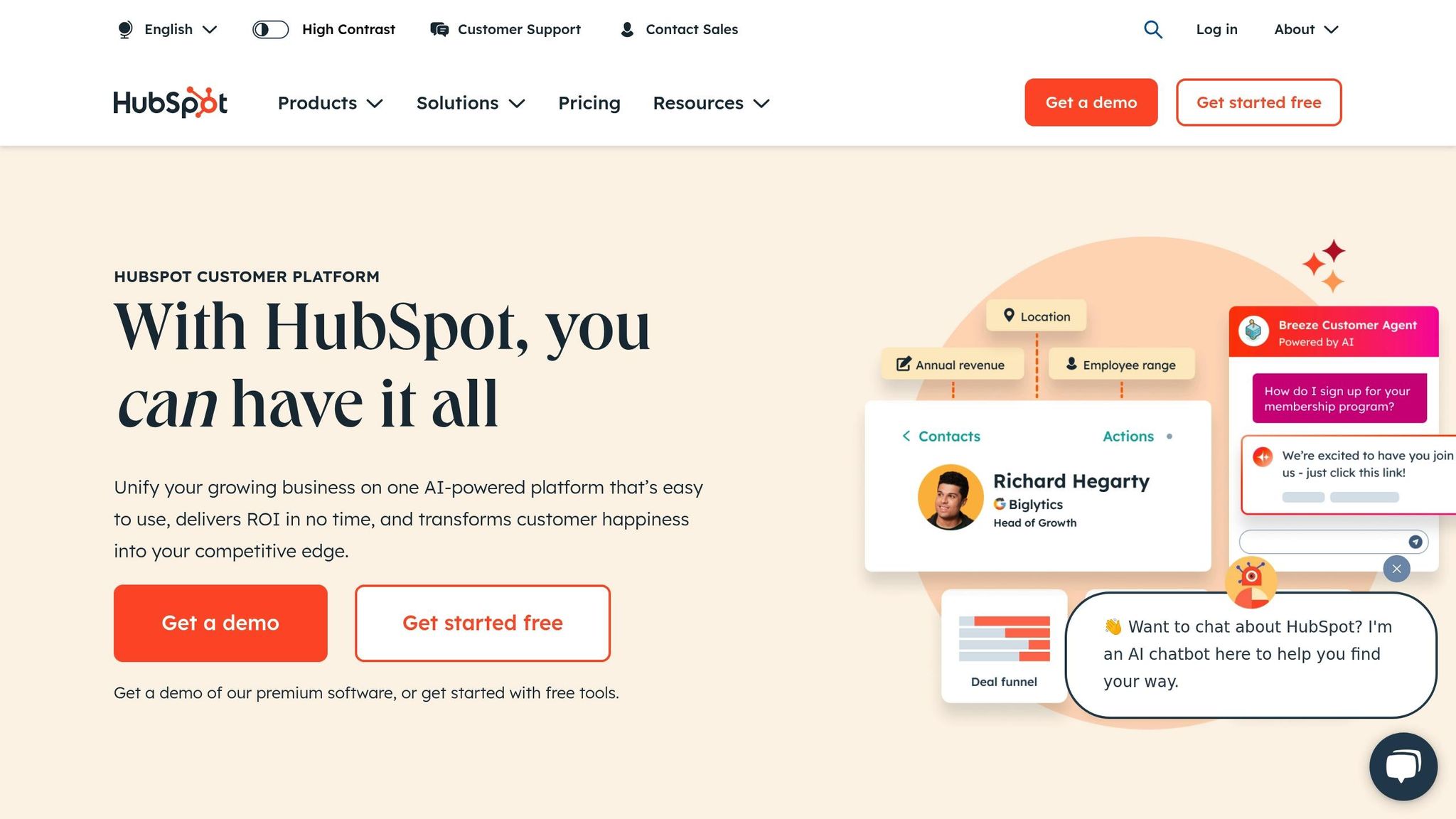
HubSpot is a no-code marketing automation platform designed to simplify marketing processes for Australian businesses. Its all-in-one design is particularly appealing for those wanting to automate their marketing efforts without needing technical expertise.
HubSpot provides advanced workflows triggered by filter-based and event-based criteria. You can create these workflows from scratch or use pre-designed templates. They handle tasks like sending birthday emails, running countdown campaigns, assigning leads to sales teams, generating records, and updating data in Google Sheets. Additional features include lead scoring, contact segmentation, and social media management tools for posting across platforms. Plus, it offers custom landing pages and detailed analytics with A/B testing capabilities.
HubSpot is highly rated, with scores above 4.4 on major review sites, thanks to its user-friendly design. Its drag-and-drop email builder and custom dashboards make it easy for non-technical users to create and manage campaigns. To top it off, HubSpot Academy offers extensive courses to help users maximise their skills. These tools make it easier to craft highly personalised marketing strategies.
"I built three websites, which I manage completely via the HubSpot tools. I'm able to generate inbound traffic through various marketing efforts (blogging, emailing, posting on social media, website building,…). I manage all the incoming traffic via various analytics and insights. It is satisfying to notice that my hard work pays off."
– Charline F., Communication Manager
HubSpot excels at lead nurturing and personalisation. It enables tailored email campaigns based on customer preferences, past purchases, or website activity. For instance, a health and wellness store could send follow-up emails with discounts to customers who browsed vegan supplements but didn’t complete their purchase. Its lead capture forms and automated workflows ensure timely, personalised communication, while advanced contact segmentation helps deliver messages that resonate with specific audience groups.
Loom, for example, used HubSpot Marketing Hub Enterprise to boost demand generation by 80%. Marketing automation through HubSpot has been shown to increase leads by 80% and improve sales productivity by 14%. Additionally, 76% of companies reported a positive return on investment within a year of using the platform.
HubSpot offers a tiered pricing structure, starting with a free version that includes basic tools. The Marketing Hub also has paid plans that unlock advanced automation features, additional contacts, and premium tools. Keep in mind that Marketing Hub pricing is higher compared to the Sales Hub.
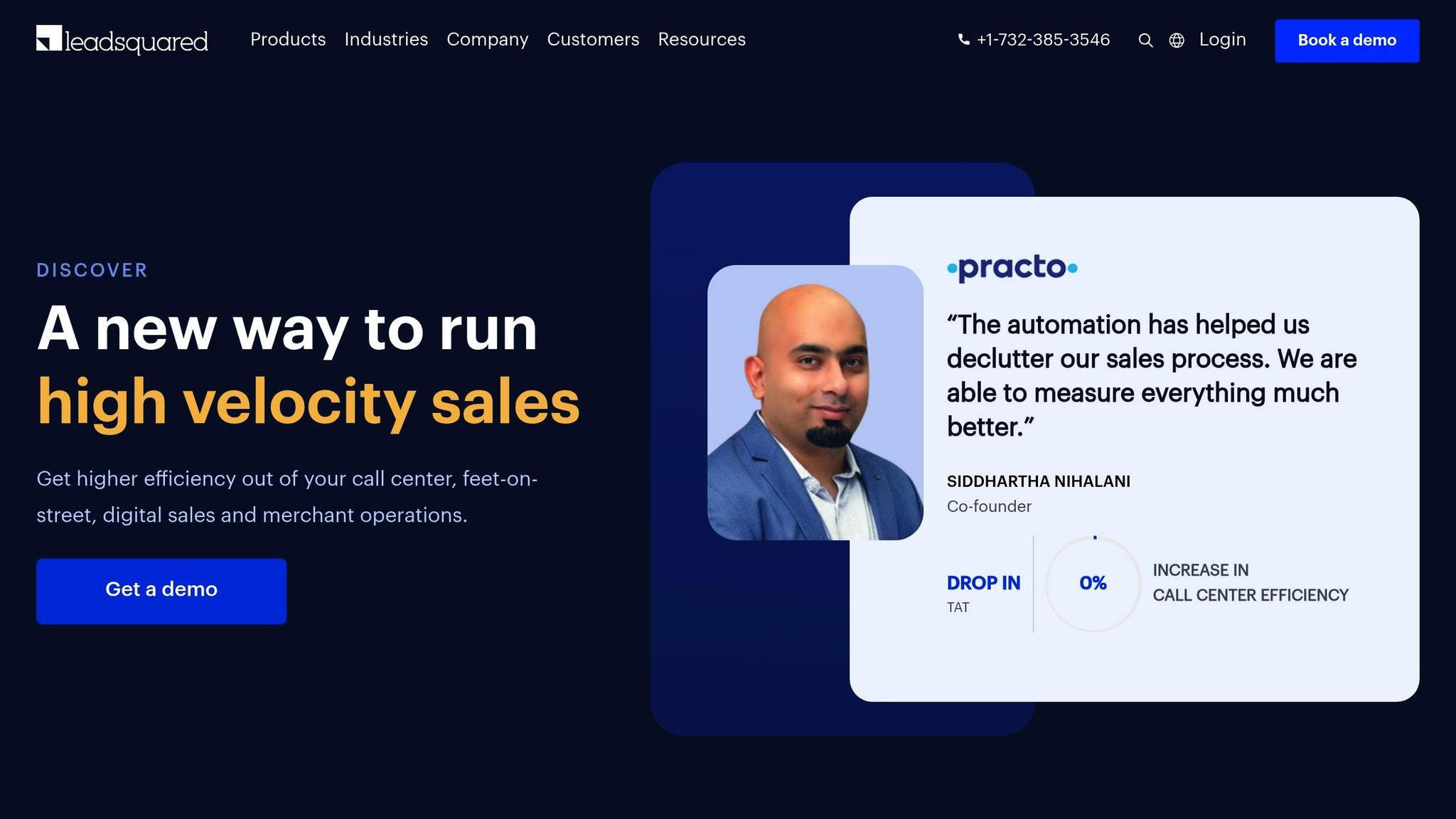
LeadSquared continues to make life easier for non-technical marketers by focusing on multi-channel engagement. This no-code marketing automation platform helps capture and analyse leads from various sources, offering a visual approach to automation. It's a practical choice for Australian businesses aiming to simplify their marketing efforts without diving into technical complexities.
With LeadSquared's drag-and-drop engine, you can create workflows that respond to user actions across multiple channels like email, SMS, WhatsApp, phone calls, and social media. For instance, you can build trigger-based workflows that automatically engage prospects when they download a resource or visit crucial pages.
The platform includes a customisable lead scoring system, allowing you to prioritise prospects based on their activity and engagement. It integrates effortlessly with CRMs and other third-party tools, automating lead capture and data syncing. Additionally, it supports remarketing campaigns via Facebook and Google Ads, helping you reconnect with prospects who initially didn't convert.
These features combine to deliver a smooth and intuitive user experience.
LeadSquared earns a 4.3/5 rating for its user-friendly design. Its clean interface ensures that even non-technical users can navigate and customise workflows with ease. The no-code functionality means you can tweak workflows quickly, keeping full control over your campaigns.
"The user interface deserves a mention here - its drag-and-drop workflow builder and clear lead journey visualisation make campaign setup surprisingly fast, even without deep technical skills." – Software Expert, research.com
LeadSquared's automation capabilities shine in lead nurturing and targeted campaign management. It’s particularly effective for Below The Line (BTL) marketing efforts and identifying upselling or cross-selling opportunities by tracking prospect behaviour and engagement. You can also design intent-based workflows to gradually qualify website visitors into sales-ready leads.
The platform's real-world impact is evident. For example, Tandem Care improved its responsiveness by over 40% using LeadSquared's automation tools, leveraging real-time reports to enhance caregiving services. Similarly, Helped streamlined its patient management processes and eliminated lead leakage by adopting LeadSquared.
"A combination of clearly defined processes and LeadSquared's automation has made our operations completely error-free. Automated lead assignment also helps us save a lot of time and bandwidth, and we can focus on what we do best - provide good insurance advice and service." – Lokesh Gurram, Co-founder, Ditto Insurance
LeadSquared offers tiered pricing plans tailored to businesses of different sizes and needs. Pricing depends on factors like the number of contacts and required features. Australian businesses can expect rates that scale with their growth, but for exact AUD pricing, you'll need to contact their sales team directly for a customised quote.
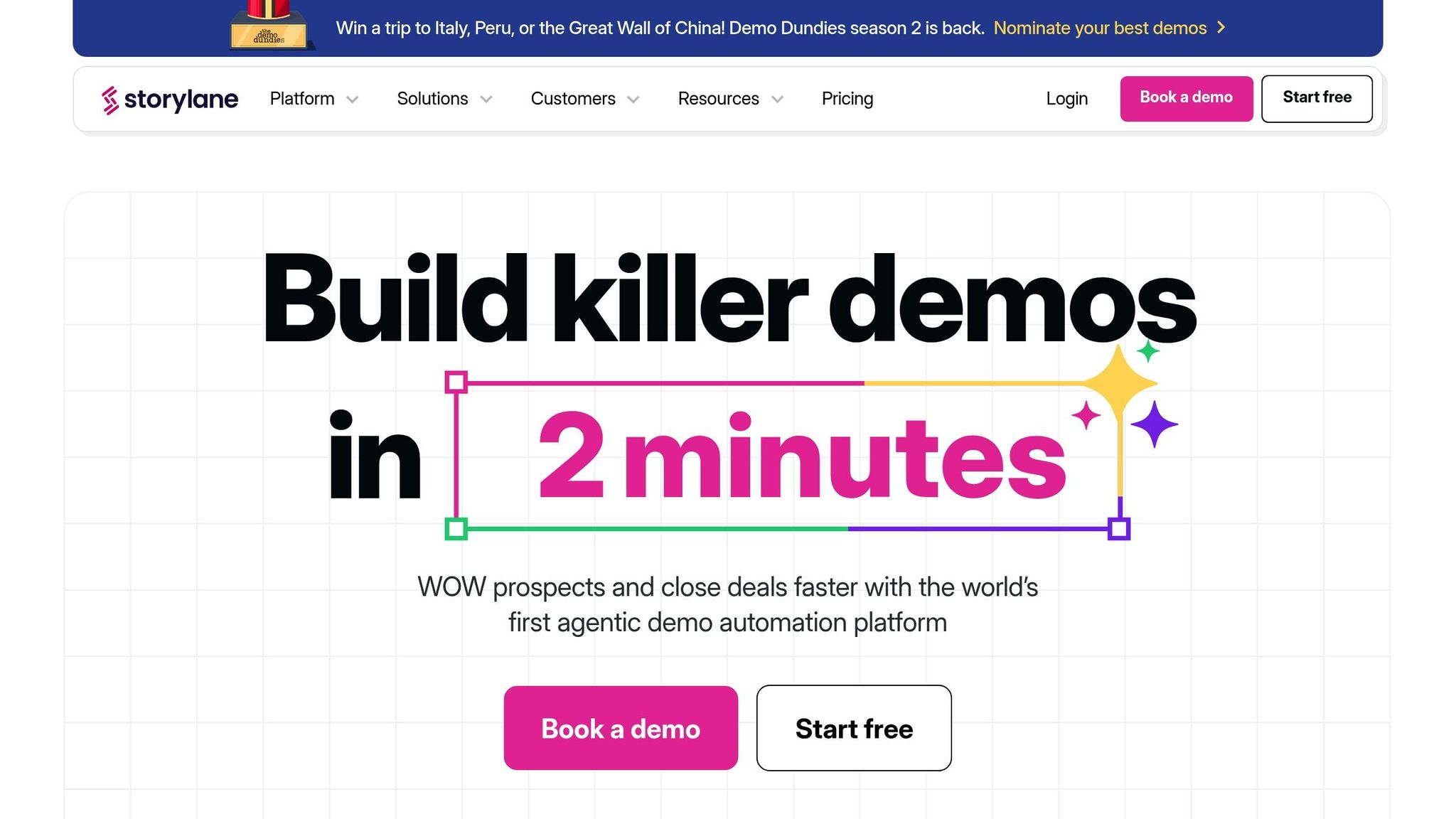
Storylane is a no-code interactive demo platform that’s reshaping how Australian businesses showcase their products. Instead of relying on static slides or lengthy product videos, it allows you to create clickable, interactive demos that prospects can explore at their own pace. This approach is particularly useful for SaaS and tech companies that need to explain complex features without overwhelming potential customers. It also ties in seamlessly with the workflow and campaign automation tools discussed earlier.
Storylane shifts the focus from traditional automation to delivering hands-on, engaging product experiences.
Storylane integrates smoothly with popular marketing and sales tools, making it a powerful addition to your tech stack. It connects with CRMs like Salesforce, HubSpot, and Freshsales, while also supporting marketing platforms such as Marketo and Pardot. With Zapier, it syncs engagement data across thousands of apps, triggering follow-ups effortlessly. Additionally, it offers native integrations with Google Analytics, Segment, Slack, and Intercom, ensuring demo metrics are channelled directly into your CRM for actionable insights.
According to Gino Gagliardi, Website Product Owner:
"It's very helpful to be able to see which companies viewed the demo and to push demo data as properties to HubSpot as an automation handle."
– Gino Gagliardi
Creating demos with Storylane is straightforward, even for those without technical expertise. Its drag-and-drop interface has earned a 4.8/5 rating and a 99/100 satisfaction score, making it accessible for a wide range of users. That said, crafting more intricate demos may require some additional effort.
Ankit P., a satisfied user, shares:
"Storylane allows you to create demos which can showcase the features and benefits of your product in a dynamic and user-friendly manner, helping potential customers understand its value more effectively. There is no coding required, and it has ease of use, enabling our users to create detailed and interactive product demonstrations without needing any coding skills."
– Ankit P.
Storylane shines in demand generation and sales enablement, particularly for B2B companies with complex offerings. Its interactive demos generate up to three times more engagement compared to traditional videos. Real-world examples include:
The platform is especially valuable for product marketing teams unveiling new features and sales teams needing engaging demo tools. SentinelOne, for instance, integrated Storylane into their campaigns and sales processes within just two months. As Harry Solomon, Director at Ignition, explains:
"Storylane fits in perfectly to nurture our customers...how we want to optimise our funnel, and how we ultimately want to run as a marketing team, which is data-driven."
– Harry Solomon, Director, Ignition
Storylane offers tailored pricing based on your specific needs and usage. Australian businesses can contact the sales team directly for quotes in AUD. Costs vary depending on factors like the number of demos, integrations, and team size. The pricing model is designed to scale alongside your business, making it suitable for startups and established enterprises alike.
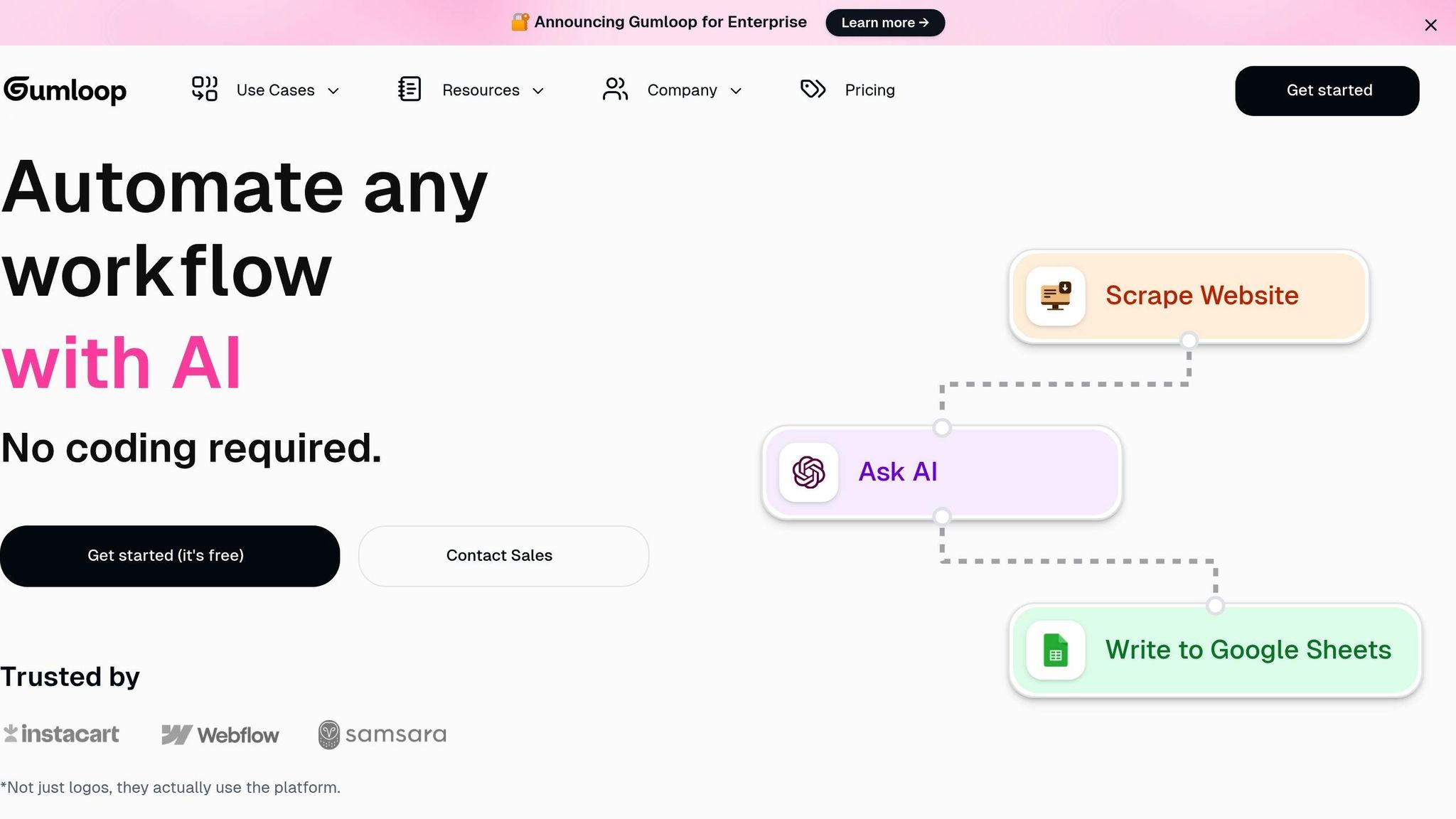
Gumloop is an AI-powered, no-code automation platform designed to simplify complex workflows for marketing teams in Australia. Unlike traditional automation tools that rely on basic trigger-action setups, Gumloop combines artificial intelligence with an intuitive visual workflow builder. This blend allows marketers to create advanced automations capable of analysing and adapting to various scenarios.
What makes Gumloop stand out is its AI-native features, seamlessly integrated into its drag-and-drop interface. This makes it an excellent choice for handling data-heavy tasks like lead scoring, content analysis, and gathering competitor insights.
Gumloop delivers a wide range of automation options, from simple data transfers to in-depth AI-driven tasks. It excels in document processing - handling tasks like extracting, categorising, summarising, and populating forms. It also supports web scraping, enabling teams to gather competitive intelligence, monitor pricing, and collect market data. For marketing professionals, this means automating workflows like processing lead forms, analysing competitor reports, or summarising insights from industry whitepapers.
Its SEO automation tools integrate with platforms like Google Analytics and Semrush, streamlining keyword research, content analysis, and performance tracking. CRM automation connects effortlessly with Salesforce and HubSpot, simplifying tasks such as data entry, lead tracking, and follow-up communications. For email marketing, Gumloop automates campaign creation, subscriber list management, behavioural triggers, and performance monitoring.
The platform’s trigger system is highly versatile, supporting time-based actions, webhooks, and platform-specific triggers (e.g., Gmail, Slack, Airtable), allowing seamless integration across various tools. Despite its advanced features, the design remains approachable, making it accessible even to non-technical users.
Gumloop’s user-friendly design ensures that even those without technical expertise can quickly adapt. With a 4.5/5 rating for ease of use, users frequently highlight its intuitive drag-and-drop interface. This interface allows users to build workflows by connecting modular components - called nodes - on a visual canvas, with AI features enhancing the process.
"You can automate complex workflows without writing a single line of code - the drag-and-drop interface lets you build your own processes by connecting modular components, known as nodes, on a visual canvas. This means nearly anyone on your team can use the tool to create their own automations without the help of developers."
Whether starting with pre-built templates or creating custom workflows from scratch, users can easily test and refine their setups before launching. One user shared their enthusiasm:
"The Gumloop UI/UX is so good... You can tell the team really understands how to build products that are delightful to use. I often judge products by the emotional response they create, and Gumloop just feels good to use." – Omid G, Founder of Marketer Milk
Gumloop shines in streamlining essential marketing activities. For example, lead scoring and qualification becomes more effective with AI analysing multiple data points, such as social media interactions and engagement patterns, to score prospects automatically.
Competitive intelligence is another area where Gumloop excels. It can automate tasks like competitor keyword research, content audits, and building custom SEO monitoring tools. Marketing teams can set up workflows to track competitor pricing, content strategies, and campaign activities in real time.
Content marketing automation also benefits from Gumloop’s capabilities. Teams can use it to analyse trending topics, generate content briefs, and create SEO-optimised outlines based on keyword research and competitor analysis.
The platform’s impact is undeniable. Ben Stagakis from Triptease shared:
"Gumloop is gamechanging. It helped my team generate 65% more meetings YoY and win 207% more revenue. I don't think we've even scratched the surface." – Ben Stagakis, Triptease
Teams are finding novel ways to use Gumloop. For instance, one user automated the process of converting YouTube tutorials into formatted standard operating procedures, while another created workflows to search Google Images and automatically populate spreadsheets.
Gumloop offers flexible pricing plans to suit various team sizes and needs. The Free plan gives users 1,000 credits to explore the platform’s features.
The Starter plan, priced at approximately $97 AUD per month, is ideal for smaller teams beginning their automation journey. For larger teams with more complex needs, the Pro plan costs around $297 AUD per month. Custom pricing is also available for enterprise-level solutions, offering tailored features and dedicated support.
With a cost-efficiency rating of 4.2/5, users appreciate the value Gumloop provides, particularly when considering its potential to boost productivity and drive revenue.
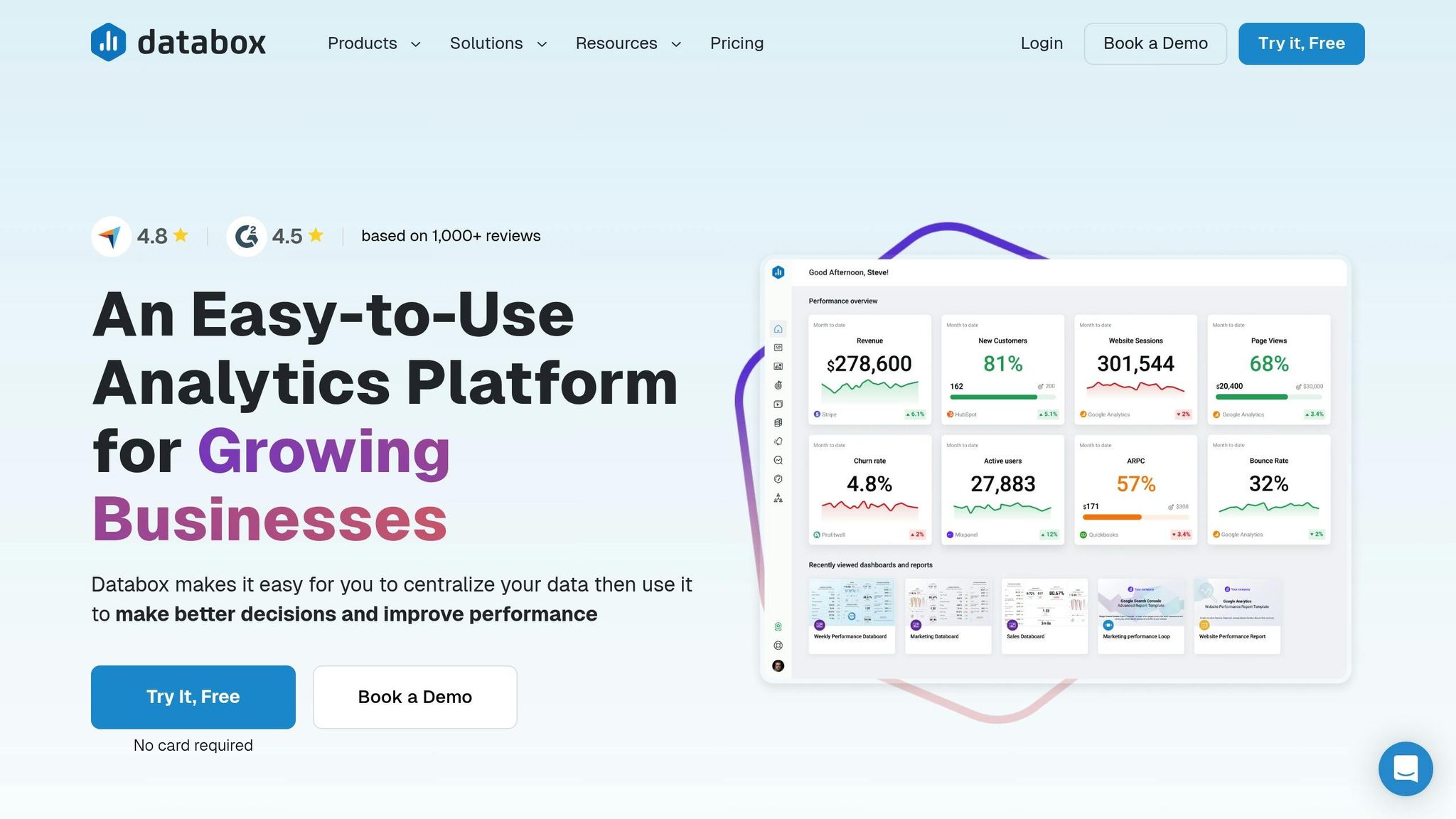
Databox is a business analytics platform designed to streamline data management by consolidating information from over 100 software tools, APIs, databases, and spreadsheets into one centralised dashboard. This setup provides a unified view of your business metrics, saving you from jumping between platforms to track performance. With over 200,000 customers globally, Databox has gained traction among Australian marketing teams for its clear data visualisation and reporting capabilities. By merging diverse data sources, it transforms raw numbers into actionable insights.
Databox simplifies marketing automation with its no-code approach to data management. It integrates seamlessly with tools like Google Analytics 4, HubSpot Marketing, Facebook Ads, Google Ads, Instagram Business, Mailchimp, LinkedIn Ads, ActiveCampaign, and Klaviyo. For workflow automation, it connects with Zapier and Make, enabling users to create workflows that trigger specific actions based on data thresholds or performance metrics. Additional integrations include APIs for Slack, Twilio, and ConvertKit, as well as direct SQL connections for MySQL and PostgreSQL databases. The Metric Builder feature allows users to craft custom metrics with filters and segmentation - no coding required.
A real-world example highlights the platform's capabilities. In December 2024, a digital marketing agency utilised Databox's custom workflows to score leads based on engagement metrics like ad interactions, website visits, and inquiry form submissions. Once leads hit certain thresholds, automated actions were triggered, such as assigning leads to team members, sending tailored emails, and scheduling follow-up calls [Source: Databox Blog, 2024].
Databox is built with simplicity in mind, making it accessible even to those without technical expertise. The drag-and-drop dashboard builder allows marketers to create visual reports effortlessly, eliminating the complexity associated with many analytics platforms. Most users can set up their first dashboard in under five minutes, enabling teams to quickly turn complex data into actionable insights without needing IT support. Pre-built templates and metrics further simplify the process, while personalised customer service ensures businesses receive the guidance they need. The platform consistently earns high ratings on review sites like G2 and Capterra, with users praising its intuitive design and responsive support.
Databox is particularly effective for cross-channel performance tracking and data blending - key tasks for marketing teams. By consolidating data from various sources into a single visual interface, marketers can easily compare campaign performance across platforms. This unified view complements other no-code tools, helping teams optimise campaigns more efficiently. For instance, in April 2024, 301 Digital Media, led by Angie Bisig, used Databox to merge data from multiple sources, significantly cutting down the time spent on preparing client reports and enabling a sharper focus on campaign optimisation [Source: Databox Blog, 2024].
Another standout use case is marketing ROI analysis. Coalition Technologies, under Jordan Brannon, combined data from Google Ads, Google Analytics, and a client's CRM to create a comprehensive view of campaign performance [Source: Databox Blog, 2024]. Similarly, A Self Guru, led by Amira Irfan, enhanced its reporting process by automating tasks and integrating business intelligence tools to present data in an easily digestible format [Source: Databox Blog, 2024].
Data blending is a widely adopted practice, with 92.6% of surveyed companies using it and 59.3% finding it highly effective for marketing. Databox supports this with pre-built dashboard templates tailored for marketing automation tools like HubSpot, Mailchimp, Klaviyo, ActiveCampaign, SendGrid, Campaign Monitor, Pardot, and Marketo. This makes it an invaluable resource for simplifying complex data and driving marketing success.
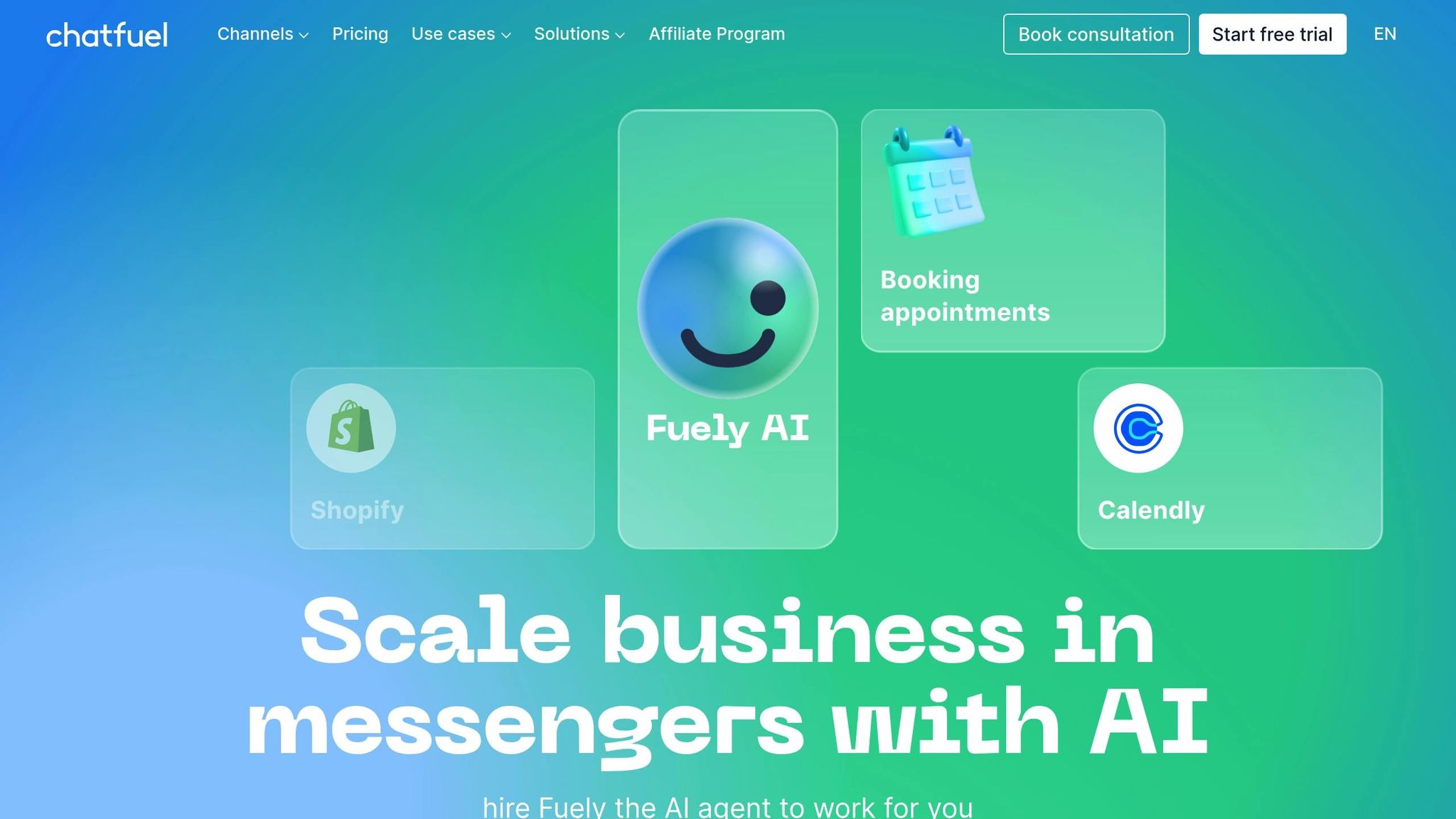
Chatfuel is a no-code chatbot platform designed to help businesses automate their communications on Facebook, Instagram, and WhatsApp - no technical skills required. With a thriving Facebook community of 75,000 members, Chatfuel has become a go-to solution for small and medium businesses around the world. Its user-friendly flow builder and AI-powered tools make it a practical option for Australian businesses aiming to simplify customer interactions and marketing tasks.
One of Chatfuel’s standout features is its ability to integrate seamlessly with tools like Zapier and Make. These integrations open the door to thousands of apps, allowing businesses to build complex workflows without writing a single line of code.
"Amplify your automation capabilities with Fuely AI's integration with Zapier, bridging your chat services with over 3,000 apps to automate workflows, sync data, and enhance functionality."
- Chatfuel.com
Chatfuel also comes with built-in keyword recognition and ChatGPT integration, enabling AI-driven conversations that can automatically respond to comments and mentions on social media. In July 2023, Chatfuel showcased how its tools help users automate tasks like organising leads, scheduling events, and creating email contacts via connected workflows (Chatfuel Blog, July 2023). Businesses can store contact details in custom fields, drive traffic from social media, and use the platform’s live chat features. For e-commerce, Shopify integrations add another layer of automation, making Chatfuel a solid choice for businesses juggling online sales and customer support.
Chatfuel is designed with accessibility in mind, offering a drag-and-drop interface that lets users deploy chatbots on Messenger in just a few minutes. Its simplicity has earned it high praise, with Capterra users rating it 4.6 out of 5. Overall, the platform scores 4.3 out of 5 on Capterra (28 reviews) and 4.5 out of 5 on G2 (44 reviews).
"The simplicity of building a chatbot is impressive even if you have zero skills."
- Pierfrancesco Maria P., CEO & Founder
While the platform’s intuitive design is widely appreciated, some users might need tutorial videos to fully grasp its potential. On average, Zapier users can set up automated workflows in less than six minutes, highlighting Chatfuel’s focus on ease of use.
Chatfuel shines in a variety of marketing scenarios. It’s ideal for lead generation, customer support, FAQ automation, feedback collection, re-engagement campaigns, and even direct sales. For Australian businesses, its ability to automatically reply to social media comments and story mentions ensures consistent engagement without requiring manual effort. Chatfuel also helps drive traffic from social channels while capturing contact details, making it a valuable tool for building marketing databases. Marketing teams can manage conversations across Facebook, Instagram, and WhatsApp from a single platform, while built-in analytics provide insights to refine strategies over time.
"The secret to taking your business to the next level: marketing automation."
- Bojana Vojnović, Chatfuel Blog
Chatfuel offers flexible pricing plans to suit businesses of all sizes. The Business plan starts at approximately $35 AUD per month (converted from $23.99 USD), with additional conversations costing around $0.03 AUD each. For larger organisations, the Enterprise plan begins at roughly $440 AUD per month (converted from $300 USD).
Automation is a game-changer for Australian businesses, and choosing the right no-code tool can make all the difference. Here's a quick comparison of popular tools, highlighting their features, pricing (in AUD), and best use cases.
| Tool | Core Features | Starting Price (AUD/month) | G2 Rating | Best For |
|---|---|---|---|---|
| Zapier | 7,000+ app integrations, multi-step workflows, AI automation, webhook support, team collaboration | $20 (Free plan available) | 4.5 | Streamlining app integrations and automating workflows |
| HubSpot | All-in-one CRM, email marketing, lead scoring, campaign automation, social media tools, analytics | $50 (Free plan available) | 4.4 | Aligning marketing and sales efforts comprehensively |
| LeadSquared | Drip campaigns, triggered communication, marketing attribution, campaign analytics, lead management | Custom pricing | N/A | Managing B2B leads and sales pipelines effectively |
| Storylane | Interactive product demos, personalisation, analytics, sharing capabilities, no-code demo builder | $40 | N/A | SaaS companies showcasing detailed product features |
Nearly half of companies (49%) report growth through marketing automation tools. Entry-level pricing starts at $20 AUD/month for tools like Zapier, while more feature-rich options like HubSpot begin at $50 AUD/month. Both tools consistently earn high user ratings, with Zapier leading at 4.5 stars and HubSpot close behind at 4.4 stars.
Each tool excels in specific areas. For instance, Zapier is perfect for businesses needing versatile integrations and simple automation. HubSpot offers a robust platform for marketing and sales alignment. Storylane shines with its interactive product demos tailored for SaaS companies, while LeadSquared focuses on nurturing B2B leads and managing sales pipelines.
The impact of these tools is clear - 80% of users report generating more leads, and 77% see improved conversions. For Australian businesses just starting out, the free plans and strong community support offered by Zapier and HubSpot make them excellent choices. They provide flexibility to scale without requiring a platform change, backed by extensive documentation and user-friendly interfaces.
No-code marketing automation tools are reshaping how Australian businesses tackle their marketing efforts. The seven tools highlighted here demonstrate that you don't need coding expertise to build effective marketing workflows. Whether it's Zapier's seamless integrations or HubSpot's robust CRM features, these platforms provide practical solutions for businesses of all sizes.
As Andre Alexopoulos, COO of SMSGlobal, puts it:
"No-code integrations have become mainstream tools integral to today's digital marketing operations."
The real strength of these tools lies in how accessible and adaptable they are. Marketing teams can implement automation on their own terms, bypassing the need for developer resources. In fact, 66% of marketers report that automation lets them focus on creative tasks, while 80% of marketing developers agree these tools are essential for eliminating repetitive work.
To make the most of these benefits, having local expertise on hand can be a game-changer. Start by identifying a tool that aligns with your business needs, budget, and growth plans. Free trials are a great way to explore functionality, and building a proof of concept can ensure the tool fits seamlessly into your workflow. With behaviour-based campaigns capable of increasing conversion rates by up to 25%, the potential return on investment is hard to ignore.
For Australian businesses looking to dive into no-code automation, Lightning Ventures can provide the guidance you need. They specialise in business process automation with platforms like Bubble and offer workshops on AI, automation, and startup strategies. Their tailored approach ensures you maximise the value of your automation tools.
With no-code marketing automation, businesses can unlock new opportunities for growth and streamline their operations. The future of marketing is here - accessible, efficient, and ready to drive innovation.
No-code tools for marketing automation offer Australian businesses a practical way to save time and work more efficiently. By handling repetitive tasks and cutting down on manual errors, these tools allow teams to focus on higher-value activities. For small and medium enterprises, this can be a game-changer, enabling smoother operations without depending heavily on coding expertise or IT departments.
These platforms also support quicker campaign rollouts, enhance flexibility, and lower costs by removing the need for complex development processes. With automation in place, businesses can fine-tune their marketing strategies, respond swiftly to market shifts, and rely on data to make informed decisions - all critical for staying ahead in today’s fast-paced landscape.
To find the best no-code marketing automation tool for your business, start by clearly defining your goals and needs. Ask yourself what tasks you want to automate, which integrations are essential, and how much you're willing to spend. Pay attention to features like user-friendliness, customisation capabilities, and scalability - these will ensure the tool fits your business size and technical know-how.
Don’t forget to check how well the tool works with your current systems and whether it includes strong security measures, especially for managing Australian data. By keeping these factors in mind, you can choose a tool that’s easy to use, adaptable, and perfectly suited to your marketing objectives.
No-code tools like Zapier and HubSpot can make marketing tasks a lot easier by automating those tedious, repetitive processes. Take Zapier, for example - it can automatically move leads from sources like Google Sheets or Gmail straight into HubSpot. This means no more manual data entry, and your lead database stays current without you lifting a finger.
On the flip side, HubSpot works seamlessly with Zapier to create automated workflows. Think tasks like adding new contacts to a spreadsheet or sending out follow-up emails - handled automatically. These tools don’t just save you time; they also help ensure your data is accurate, giving you more room to focus on building better campaigns. By cutting down on manual work, they make it simpler for businesses to grow their marketing efforts.